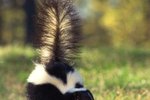
The Mephitidae family of skunks and badgers includes four species in the Conepatus genus known as hog-nosed skunks: Molina's hog-nosed skunks (C. chinga), Humboldt's hog-nosed skunks (C. humboldtii), North American hog-nosed skunks (C. leuconotus) and striped hog-nosed skunks (C. semistriatus). The genus' common name comes from these skunks' distinctive blunt noses, which resembles a pig's snout. Like all skunks, hog-nosed skunks have the ability to spray foul-smelling liquid if threatened, although they use this defense as a last resort.
Physical Characteristics
Hog-nosed skunks grow to about 2 feet long on average, and weigh between 5 and 10 pounds. In addition to their distinctive noses, skunks in this genus have coarser fur than skunk species. The fur is mostly black, with white stripes that differ in pattern depending on the species. Humboldt's hog-nosed skunks have one or two white stripes down their sides. The same two white stripes are present for Molina's hog-nosed skunks, but their tails are almost completely white. Striped and North American hog-nosed skunks have a single white stripe running down their backs, but striped skunks' single stripe splits into two, with their tails covered with short black and white hairs.
Geographic Range
All hog-nosed skunks live in the Americas. The North American species ranges farther north than any other member of the genus, living in Mexico and the United States as far north as Colorado. The other species reside in Central and South America. Striped hog-nosed skunks live as far north as southern Mexico and as far south as northern Peru and eastern Brazil. The range of Molina's and Humboldt's hog-nosed skunks overlaps. Molina's hog-nosed skunks live throughout central South America, while Humboldt's skunks live exclusively in Chile and Argentina.
Habitat
Hog-nosed skunks generally prefer open grasslands, scrublands and forests. Striped hog-nosed skunks' habitat depends on the season. During the rainy season when food is more plentiful, they tend to stay in deciduous forests, but during the dry season, they expand into more open territory in search of food. Molina's hog-nosed skunks prefer foraging in open canyon and steppe areas, though they retreat to forests to rest. While Humboldt's hog-nosed skunks also prefer open grasslands, they often forage near the barns and sheds of human dwellings.
Diet and Behavior
Hog-nosed skunks eat primarily insects and small mammals, particularly rodents. For this reason, farmers find their presence beneficial as they prey on pests that destroy crops. Some have a more specialized diet -- striped hog-nosed skunks prefer to hunt and eat termites, while Molina's skunks favor spiders and beetles. These skunks are solitary, nocturnal creatures, foraging at night and returning to dens or burrows during the day. Molina's hog-nosed skunks are more territorial, while Humboldt's hog-nosed skunks tend to roam more and never return to the same den twice.
References
- University of Michigan Museum of Zoology Animal Diversity Web: Conepatus -- Classification
- University of Michigan Museum of Zoology Animal Diversity Web: Conepatus Humboldtii
- University of Michigan Museum of Zoology Animal Diversity Web: Conepatus Chinga
- University of Michigan Museum of Zoology Animal Diversity Web: Conepatus Semistriatus
- Smithsonian National Museum of Natural History: North American Mammals -- Conepatus Leuconotus
Photo Credits
-
Jupiterimages/Photos.com/Getty Images
Writer Bio
Jennifer Mueller began writing and editing professionally in 1995, when she became sports editor of her university's newspaper while also writing a bi-monthly general interest column for an independent tourist publication. Mueller holds a Bachelor of Arts in political science from the University of North Carolina at Asheville and a Juris Doctor from Indiana University Maurer School of Law.




